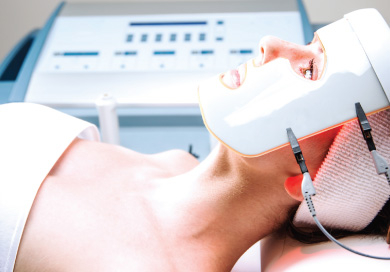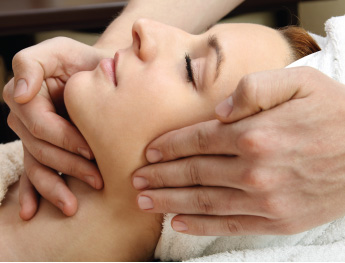It is amazing to me how much the skin care profession has changed in just 25 years. Gone are the days of the traditional basic facial treatment. They have replaced with acids, enzymes, peptides, currents, lights and frequencies. It is mind blowing! Just as equally mind blowing can be trying to decide just what to do with it all and which to choose to incorporate into your skin care practice. Every practice is different and every aesthetician is different. It really comes down to modalities best suited for each individual situation; however, I have chosen three that are tried and true, easy to incorporate, affordable, and proven to deliver amazing results. There certainly are many others that I love, but galvanic current, light-emitting diode (LED) and pressure point massage are at the absolute top of my list… let me tell you why!
Galvanic Current
 Galvanic current has been a staple in the skin care practice since the early 1930s. Long known and used in European facial therapy, it still remains a skeptical modality in American skin care. Galvanic current is one directional current used to force a water soluble product deep into the skin. Aside from today’s technologically advanced peptides, acids, and liposomes, it stands alone as one of the only ways to force product past the acid mantle (the most protective barrier of the epidermis) in order to deliver product deep into the lower layers of the epidermis.
Galvanic current has been a staple in the skin care practice since the early 1930s. Long known and used in European facial therapy, it still remains a skeptical modality in American skin care. Galvanic current is one directional current used to force a water soluble product deep into the skin. Aside from today’s technologically advanced peptides, acids, and liposomes, it stands alone as one of the only ways to force product past the acid mantle (the most protective barrier of the epidermis) in order to deliver product deep into the lower layers of the epidermis.
This process of forcing a water soluble product into the skin is called phoresis. Using a positive current as the active electrode is called cataphoresis. It saturates the layers of the epidermis with nutrient rich, acid ingredients (not acids... I am referring to positively charged products that have a lower pH and are on the “acid” side of the pH scale) from whichever type of water soluble treatment product you choose to use. Think about the treatment products that you use in your cabin. Serums and concentrates for anti-aging, pigmentation, glycation, inflammation, dehydration, elastosis, or any other skin concern, can be forced deep into the layers of the epidermis to have even more powerful effects than when used alone. Cataphoresis can be performed before or after facial massage, as well as before or after the treatment mask – whichever suits your treatment regimen with that client. You simply cannot go wrong with iontophoresis!
When utilizing a negative current as the active electrode, phoresis is now referred to as anaphoresis. Anaphoresis is using a negative current to force a water soluble alkaline product deep into the layers of the epidermis. The dual benefit in this treatment is the effect of alkaline product, most likely a desincrustation solution, which softens the pores and dissolves sebum, allowing you to deeply cleanse oily and acneic skin and perform superior extractions. Anaphoresis is performed after exfoliation and prior to extractions. It is a must-use modality for any aesthetician aiming to improve a client’s skin that struggles with excess oil, clogging and acne breakouts. Galvanic current machines can be purchased individually for as little as a few hundred dollars or as a standard part of any multifunction machine.
LED Therapies
 Light emitting diodes (LED) and many other light based therapies have been at the top of the controversy list for several years. Although lasers and intense pulsed lights (IPL) receive the majority of the hype, there are just a few states that restrict light emitting diodes, as well. LEDs cellular benefits were first noted by NASA. Not the place you would expect to discover skin care modalities, but it was NASA research that discovered that LEDs had the ability to generate photosynthesis in space and actually grow plants. Further research discovered its ability to not only sustain normal cell growth, but to also enhance wound healing and prevent both bone and muscle loss. Studies show that cells exposed to LED lights, particularly infrared, underwent growth and repair up to 200 percent faster than those that were unexposed. This research steered the skin care industry into a deluge of research in various LED wavelengths and their effects on the skin. The first U.S. Food and Drug Adminstration (FDA) approved LED was an amber light, manufactured by a company called Gentlewaves. It was clinically proven to increase collagen production in the skin. Now keep in mind, nothing happens overnight; multiple treatments were required over several weeks with results appearing gradually over time; nevertheless, the results were significant.
Light emitting diodes (LED) and many other light based therapies have been at the top of the controversy list for several years. Although lasers and intense pulsed lights (IPL) receive the majority of the hype, there are just a few states that restrict light emitting diodes, as well. LEDs cellular benefits were first noted by NASA. Not the place you would expect to discover skin care modalities, but it was NASA research that discovered that LEDs had the ability to generate photosynthesis in space and actually grow plants. Further research discovered its ability to not only sustain normal cell growth, but to also enhance wound healing and prevent both bone and muscle loss. Studies show that cells exposed to LED lights, particularly infrared, underwent growth and repair up to 200 percent faster than those that were unexposed. This research steered the skin care industry into a deluge of research in various LED wavelengths and their effects on the skin. The first U.S. Food and Drug Adminstration (FDA) approved LED was an amber light, manufactured by a company called Gentlewaves. It was clinically proven to increase collagen production in the skin. Now keep in mind, nothing happens overnight; multiple treatments were required over several weeks with results appearing gradually over time; nevertheless, the results were significant.
In skin care treatments today, there are three LED wavelengths that are used to improve the health and condition of the skin. As noted above, amber LEDs are at a wavelength of 605nm and increase collagen and elastin production. Red LED wavelengths are 660nm and shown to reduce inflammation, as well as trigger collagen production. Blue LED wavelengths are at 415nm and are antibacterial. A fourth LED, infrared, is 855nm and used to promote healing and circulation. Infrared is not as commonly found, but is manufactured by reputable and FDA approved LED companies and proven to deliver amazing results to the skin.
Each of these LED wavelengths has its place in the treatment room. Reds and ambers are ideal for anti-aging and rosacea treatments, as well as boosting the overall integrity of the skin. Blues are commonly used for treatments trying to improve acne and rosacea. LED treatments are easily incorporated into any facial treatment, including microdermabrasion. Lights are held over areas to be treated for several minutes, following a treatment mask or the application of a treatment serum or concentrate. Please note that it is critical to follow your manufacturer’s instructions for use.
"LED is a simple way to update your skin care treatments, stand apart from your competitors, and maximize your results."
Pressure Point Massage
 Now let us revert back to the most basic tool of our trade – our hands! Massage techniques have long been the secret weapon that aestheticians have in their back pocket. For centuries upon centuries, massage has been used to increase circulation, detoxify, heal, calm and sooth not only the skin, but the entire body. The goals of the skin care profession are no longer primarily centered on relaxation and pampering. Today’s skin care industry is results-oriented. In order to maximize results, skin care professionals must focus on the link between the condition of the skin and the health and condition of the inner body.
Now let us revert back to the most basic tool of our trade – our hands! Massage techniques have long been the secret weapon that aestheticians have in their back pocket. For centuries upon centuries, massage has been used to increase circulation, detoxify, heal, calm and sooth not only the skin, but the entire body. The goals of the skin care profession are no longer primarily centered on relaxation and pampering. Today’s skin care industry is results-oriented. In order to maximize results, skin care professionals must focus on the link between the condition of the skin and the health and condition of the inner body.
Various areas of the face are directly linked to a minimum of 11 internal organs of the body, including the liver, stomach, small intestines, bladder, colon, gallbladder, heart, kidneys, lungs, pancreas, and genitals. The Chinese have long known this connection and can actually make clinical health diagnosis based on looking at an individual’s skin! This is beyond our scope of practice, but a proven ability.
Applying this information and skill to the skin care treatment room is, in my opinion, the third necessary modality that every aesthetician should use. Pressure point massage takes the knowledge and skill of Chinese medicine and places a bit of its benefits into the hands of the skin care professional. Pressure point massage is shown to improve circulation, relax and destress the client. In addition, it can minimize sinus pressure and even relieve headaches. There are 15 facial energy points that lie mainly along nervous system pathways that are linked to various parts of the body. The concept behind pressure point massage is to compress these energy points that will, in turn, trigger the body’s own natural healing responses. The degree and length of pressure time can have different effects on the client’s body. It is optimal for movements to be firm, yet gentle and held for approximately one to three minutes.
During treatment it is important for you, the aesthetician, to stay focused and breathe, as well as to ensure that your client focuses on steady, deep breathing. Every treatment should conclude with offering the client a large glass of water.
One of the greatest benefits to pressure point massage is that it can be done on any skin type and any skin condition, even those that you otherwise would not work on (such as acne, rosacea and inflammation or sensitivity).
As with any new technique, practice makes perfect. Before incorporating pressure point massage, it is critical to educate yourself and do abundant research. Purchase a facial pressure point chart to keep handy in the treatment room. Study various techniques that are available in books, videos, and online. Take your time and understand the true benefits that pressure point massage can deliver.
As skin care professionals, we have the ability to change the way our clients look and feel about themselves... there is no other job more powerful and rewarding than that! Invest in yourself. Invest in your treatments. And invest in your results with dedication, passion and knowledge. Simple modalities incorporated into a facial treatment may just change the world for somebody... thanks to you.
References
“LED Device Illuminates New Path to Healing.” NASA Spinoff. NASA. <http://spinoff.nasa.gov/Spinoff2008/hm_3.html>.
”NASA Light-Emitting Diode Technology Brings Relief In Clinical Trials.” NASA. 13 Nov. 2003. <http://www.nasa.gov/home/hqnews/2003/nov/HQ_03366_clinical_trials.html>.
 Michelle D’Allaird is a New York State licensed aesthetician and International CIDESCO Diplomat. She is the owner of the Aesthetic Science Institute aesthetic schools in Syracuse and Latham, N.Y. She is a consultant and educator for international cosmetic companies around the world. D’Allaird is a contributing author to major industry trade magazines, as well as a host and speaker for International Congress of Aesthetics & Spa conferences in Miami, Philadelphia, Dallas, and Long Beach. She is also a co-author of Salon Fundamentals aesthetic textbook. Her expertise lies in education and curriculum development for aesthetic, medical, and laser courses.
Michelle D’Allaird is a New York State licensed aesthetician and International CIDESCO Diplomat. She is the owner of the Aesthetic Science Institute aesthetic schools in Syracuse and Latham, N.Y. She is a consultant and educator for international cosmetic companies around the world. D’Allaird is a contributing author to major industry trade magazines, as well as a host and speaker for International Congress of Aesthetics & Spa conferences in Miami, Philadelphia, Dallas, and Long Beach. She is also a co-author of Salon Fundamentals aesthetic textbook. Her expertise lies in education and curriculum development for aesthetic, medical, and laser courses.
Want to read more?
Subscribe to one of our monthly plans to continue reading this article.